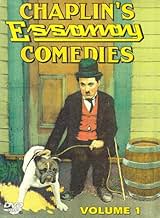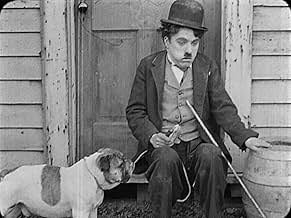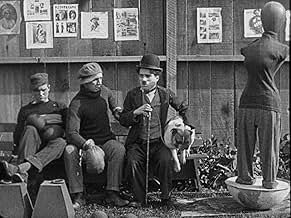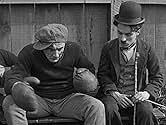IMDb-BEWERTUNG
6,7/10
2936
IHRE BEWERTUNG
Füge eine Handlung in deiner Sprache hinzuWith his bulldog, Charlie finds a good luck horseshoe as he passes a boxing camp looking for someone who can take a beating. With the horseshoe in his glove, Charlie wins and earns a fight a... Alles lesenWith his bulldog, Charlie finds a good luck horseshoe as he passes a boxing camp looking for someone who can take a beating. With the horseshoe in his glove, Charlie wins and earns a fight against the world champion.With his bulldog, Charlie finds a good luck horseshoe as he passes a boxing camp looking for someone who can take a beating. With the horseshoe in his glove, Charlie wins and earns a fight against the world champion.
- Regie
- Drehbuch
- Hauptbesetzung
Bud Jamison
- Bob Uppercut - Champion
- (Nicht genannt)
Gilbert M. 'Broncho Billy' Anderson
- Enthusiastic Fan
- (Nicht genannt)
Billy Armstrong
- Sparring Partner
- (Nicht genannt)
Lloyd Bacon
- Second Sparring Partner
- (Nicht genannt)
- …
Bill Cato
- First Sparring Partner
- (Nicht genannt)
- …
Frank Dolan
- Second Stretcher Bearer
- (Nicht genannt)
W. Coleman Elam
- Bit Role
- (Nicht genannt)
Eddie Fries
- Bit Role
- (Nicht genannt)
Daniel P. Kelleher
- Second Cop
- (Nicht genannt)
Paddy McGuire
- Sparring Partner
- (Nicht genannt)
Edna Purviance
- Trainer's Daughter
- (Nicht genannt)
Jess Robbins
- Bit Role
- (Nicht genannt)
Carl Stockdale
- Sparring Partner
- (Nicht genannt)
Ben Turpin
- Ringside Vendor
- (Nicht genannt)
Ernest Van Pelt
- Spike Dugan
- (Nicht genannt)
Leo White
- Crooked Gambler
- (Nicht genannt)
Empfohlene Bewertungen
Like so many of Charlie Chaplin's early films The Champion has been subjected to a lot of tampering over the years. Depending on which print you see, the tough guy Charlie knocks out might be named Spike Dugan or Spike Henessy, his hefty opponent in the ring might be identified as Young Hippo or Bob Uppercut, leading lady Edna Purviance's presence during the training sessions may or may not be explained (in some editions she's identified as the trainer's daughter), Charlie's encounter with two cops might be deleted, and, all told, the film's running time could be anywhere from twenty minutes to as little as nine or ten. It's appalling what latter-day distributors have done to Chaplin's work; movies are renamed, scenes are rearranged or chopped out, and jokey title cards are added which are often unfunny, inappropriate and/or in poor taste. And on top of all that deliberate abuse the inevitable ravages of time and heavy usage have taken a toll on the quality of the prints themselves. Happily, however, and despite the rough treatment it has sustained, The Champion stands as one of Chaplin's funniest and most satisfying early comedies. The film boasts lots of sure-fire gags, colorful supporting players, and an especially vigorous and winning performance from the leading player himself.
During his apprenticeship at Keystone in 1914 Chaplin learned the rudiments of filmmaking from Mack Sennett, who liked his comedies low and fast. Thus, in his earliest movies Chaplin is concerned only with action and gags, and doesn't seem to care whether the viewer likes his character or not; sometimes he's an out-and-out rotter. But with this new series for the Essanay company Chaplin learned, first, to slow down a little and let things unfold as they may. More importantly, he learned to develop a sympathetic character viewers could care about.
The opening of The Champion shows Charlie sitting on a stoop with his only friend, an endearingly ugly bulldog named Spike, as they eat a meal. Charlie offers a sausage to Spike who, amusingly, chooses to eat only after the sausage has been properly seasoned. It's a charming scene and a leisurely one, and it sets an agreeable tempo. By the time the sequence is over, whether we've seen Charlie before or not, we like this poor guy and his ugly dog, and we're rooting for them. When Charlie decides to try his luck as a boxer he even manages to retain our sympathy when he employs less-than-ethical means to knock out his foe.
Later, we're troubled when Charlie appears to flirt with the idea of accepting a bribe from a crooked gambler, but ultimately the crook gets what he deserves and Charlie is more The Good Guy than ever. This sequence, in some respects, is the funniest in the entire film. Gambler Leo White is hilariously hammy, and Charlie peppers us with gags using every available prop: the paper money he grips in his mouth, the gun that points every which way, and even Leo White's villainous mustache, which Charlie reaches over and twirls one step ahead of the villain.
Everything builds towards the climactic battle. Chaplin fans taking the long view might regard this as a dry run for the big fight in City Lights, made in 1931, but for my money the boxing match in The Champion can hold its own as a great sequence in its own right. In addition to being well staged and beautifully timed, the scene features several notable participants silent film buffs will recognize. Charlie's tubby opponent in the ring is character actor Bud Jamison, at the beginning of a 30-year career supporting just about every prominent comedian of the era. In the stands meanwhile are two prominent players of the day, G. M. "Broncho Billy" Anderson and Ben Turpin. Anderson was among the very first Western stars, and also happened to be a co-founder of the Essanay company, producers of this film. Therefore Anderson was in effect Chaplin's boss, and his cameo (as a highly enthusiastic spectator) can be seen as something of a good-natured inside joke. Ben Turpin, on the other hand, had co-starred with Chaplin in his two previous comedies, but it's said that the two men didn't get along, and they went their separate ways after this point. Turpin is granted a very brief bit as a peanut vendor in the stands during the bout, clambering over spectators before he is bodily thrown out -- out of the stands, out of the film, and, in effect, out of Chaplin's orbit.
In any event, the fight makes for a funny and exciting finale, and it provides Spike the dog with one last moment of screen immortality. (Sadly, the dog was struck and killed by a car shortly after this movie was completed.) For Spike's co-star, The Champion was not only a vast improvement over his earlier work, but the first of many classic comedies.
During his apprenticeship at Keystone in 1914 Chaplin learned the rudiments of filmmaking from Mack Sennett, who liked his comedies low and fast. Thus, in his earliest movies Chaplin is concerned only with action and gags, and doesn't seem to care whether the viewer likes his character or not; sometimes he's an out-and-out rotter. But with this new series for the Essanay company Chaplin learned, first, to slow down a little and let things unfold as they may. More importantly, he learned to develop a sympathetic character viewers could care about.
The opening of The Champion shows Charlie sitting on a stoop with his only friend, an endearingly ugly bulldog named Spike, as they eat a meal. Charlie offers a sausage to Spike who, amusingly, chooses to eat only after the sausage has been properly seasoned. It's a charming scene and a leisurely one, and it sets an agreeable tempo. By the time the sequence is over, whether we've seen Charlie before or not, we like this poor guy and his ugly dog, and we're rooting for them. When Charlie decides to try his luck as a boxer he even manages to retain our sympathy when he employs less-than-ethical means to knock out his foe.
Later, we're troubled when Charlie appears to flirt with the idea of accepting a bribe from a crooked gambler, but ultimately the crook gets what he deserves and Charlie is more The Good Guy than ever. This sequence, in some respects, is the funniest in the entire film. Gambler Leo White is hilariously hammy, and Charlie peppers us with gags using every available prop: the paper money he grips in his mouth, the gun that points every which way, and even Leo White's villainous mustache, which Charlie reaches over and twirls one step ahead of the villain.
Everything builds towards the climactic battle. Chaplin fans taking the long view might regard this as a dry run for the big fight in City Lights, made in 1931, but for my money the boxing match in The Champion can hold its own as a great sequence in its own right. In addition to being well staged and beautifully timed, the scene features several notable participants silent film buffs will recognize. Charlie's tubby opponent in the ring is character actor Bud Jamison, at the beginning of a 30-year career supporting just about every prominent comedian of the era. In the stands meanwhile are two prominent players of the day, G. M. "Broncho Billy" Anderson and Ben Turpin. Anderson was among the very first Western stars, and also happened to be a co-founder of the Essanay company, producers of this film. Therefore Anderson was in effect Chaplin's boss, and his cameo (as a highly enthusiastic spectator) can be seen as something of a good-natured inside joke. Ben Turpin, on the other hand, had co-starred with Chaplin in his two previous comedies, but it's said that the two men didn't get along, and they went their separate ways after this point. Turpin is granted a very brief bit as a peanut vendor in the stands during the bout, clambering over spectators before he is bodily thrown out -- out of the stands, out of the film, and, in effect, out of Chaplin's orbit.
In any event, the fight makes for a funny and exciting finale, and it provides Spike the dog with one last moment of screen immortality. (Sadly, the dog was struck and killed by a car shortly after this movie was completed.) For Spike's co-star, The Champion was not only a vast improvement over his earlier work, but the first of many classic comedies.
'The Champion' is a nice short film by Charlie Chaplin and of course with Charlie Chaplin. Watching him I always admire his skills. I don't know if you can call it acting but whatever you call it he is great with it. This short starts as a real story but soon it can come to the moment where Chaplin can show his skills. This time in a boxing contest and the preparation before it. There are some very funny moments and most of it was not that predictable. That is the case very often in the shorts of Charlie Chaplin but not so much in this one. I also liked the way the music played together with the performances, it made the whole thing funnier. Definitely worth a watch.
It seems natural that at the very start of Chaplin's career he should make a movie in which he plays a grossly unqualified boxer who succeeds by sneaking horse shoes into his gloves. I only wonder why it didn't happen even earlier. He passes a sign saying that sparring partners are wanted, people who know how to take a punch, and heads in. We see him grow increasingly concerned as one guy after another, all bigger and stronger than him, get up to fight and return in a state of dazed semi-consciousness.
A lot of times when I watch these early comedies from Chaplin, I get the feeling that he is often trying to create at least a mildly engaging story throughout which he can throw in a lot of kicking and punching scenes, but in this movie it's the kicking and punching the drives the plot, giving the film an unusually honest feel.
High-energy physical slap-stick is what Chaplin did best at that time, and smacking around a huge mountain of a man while he dances carelessly around as only he can is certainly a treat to watch. And the climactic battle between Charlie and the meaty Bob Uppercut (or Young Hippo, depending on which cannibalized version you may see) is well-acted and fun.
Mack Sennett like his comedies to be fast paced and high energy, without too much time wasted on things like characterization or even story. But in The Champion, Chaplin proves that we can have well-developed characters, an easily discernible story, and still have enough action and solid slap-stick to keep the shorter attention spanned audience members entertained. This is definitely one of the best short comedies that Chaplin had made up to that point.
A lot of times when I watch these early comedies from Chaplin, I get the feeling that he is often trying to create at least a mildly engaging story throughout which he can throw in a lot of kicking and punching scenes, but in this movie it's the kicking and punching the drives the plot, giving the film an unusually honest feel.
High-energy physical slap-stick is what Chaplin did best at that time, and smacking around a huge mountain of a man while he dances carelessly around as only he can is certainly a treat to watch. And the climactic battle between Charlie and the meaty Bob Uppercut (or Young Hippo, depending on which cannibalized version you may see) is well-acted and fun.
Mack Sennett like his comedies to be fast paced and high energy, without too much time wasted on things like characterization or even story. But in The Champion, Chaplin proves that we can have well-developed characters, an easily discernible story, and still have enough action and solid slap-stick to keep the shorter attention spanned audience members entertained. This is definitely one of the best short comedies that Chaplin had made up to that point.
With lots of good material, an interesting (if humorously implausible) story, and some secondary characters that are used well, "The Champion" is a very good short comedy, and is easily one of the best of Charlie Chaplin's early comedies.
It begins with Charlie answering a prize-fighter's request for sparring partners, and starting from there Chaplin gets involved in some adventures that, though lacking any believability, are quite amusing. Most of the sequences make use of the secondary characters more than is usual for Chaplin's early features. Early in the story, while Charlie and the other fighters are waiting for their turn, it makes good use of the mannerisms and expressions of the others, as well as Chaplin himself. In the main fight scene, the activity in the ring is funny, creative, and well-choreographed - there are moments when it is almost as good as the celebrated boxing scene in "City Lights". That's not to say, of course, that overall this short movie approaches such a standard of greatness, but it is a well-made and entertaining little comedy.
It begins with Charlie answering a prize-fighter's request for sparring partners, and starting from there Chaplin gets involved in some adventures that, though lacking any believability, are quite amusing. Most of the sequences make use of the secondary characters more than is usual for Chaplin's early features. Early in the story, while Charlie and the other fighters are waiting for their turn, it makes good use of the mannerisms and expressions of the others, as well as Chaplin himself. In the main fight scene, the activity in the ring is funny, creative, and well-choreographed - there are moments when it is almost as good as the celebrated boxing scene in "City Lights". That's not to say, of course, that overall this short movie approaches such a standard of greatness, but it is a well-made and entertaining little comedy.
I saw the 20 minutes version. It ends with his bulldog entering the ring biting and Charles Chaplin knocking out his opponent in Round 20. I guess it's missing the romantic ending. I can understand that. This version is strictly a slapstick movie.
I like quite a lot of the slapstick. Of course, there is nothing funnier than his boxing sequence in 'City Lights' (1931). Here he's trying out several things. When he's boxing fodder, he puts a horseshoe into his glove. Then during the long boxing match, he's doing a lot of what would recognizable to most people who's seen the boxing match in 'City Lights'.
I like quite a lot of the slapstick. Of course, there is nothing funnier than his boxing sequence in 'City Lights' (1931). Here he's trying out several things. When he's boxing fodder, he puts a horseshoe into his glove. Then during the long boxing match, he's doing a lot of what would recognizable to most people who's seen the boxing match in 'City Lights'.
Wusstest du schon
- WissenswertesThe film was restored in 2014 through the Chaplin Essanay Project thanks to the financial support of the Niles Essanay Silent Film Museum.
- VerbindungenEdited into Chase Me Charlie (1918)
Top-Auswahl
Melde dich zum Bewerten an und greife auf die Watchlist für personalisierte Empfehlungen zu.
Details
- Erscheinungsdatum
- Herkunftsland
- Offizielle Standorte
- Sprachen
- Auch bekannt als
- Charlie the Champion
- Drehorte
- Produktionsfirma
- Weitere beteiligte Unternehmen bei IMDbPro anzeigen
- Laufzeit
- 31 Min.
- Farbe
- Sound-Mix
- Seitenverhältnis
- 1.33 : 1
Zu dieser Seite beitragen
Bearbeitung vorschlagen oder fehlenden Inhalt hinzufügen

































